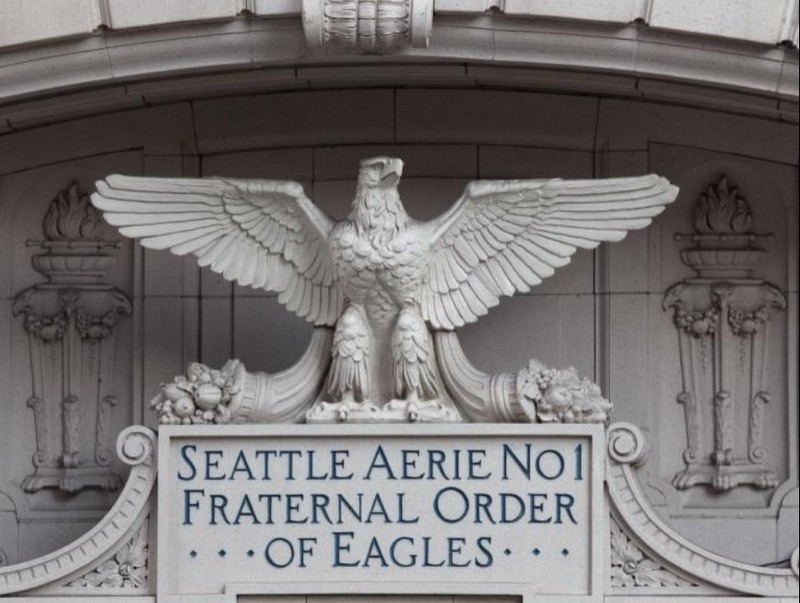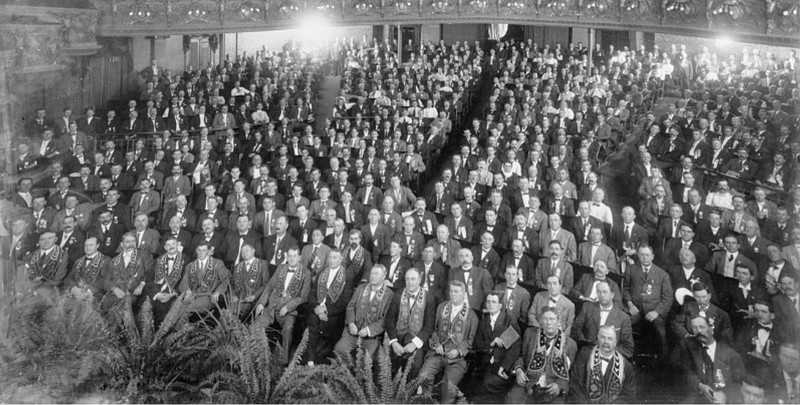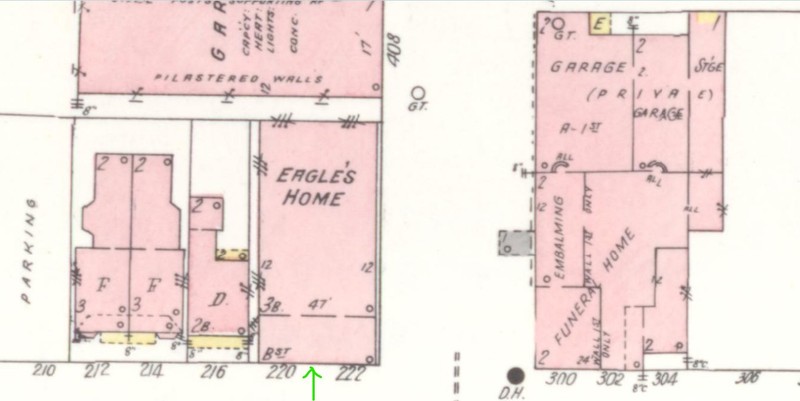Fraternal Order of Eagles Building (Marshall Street Apartments)
Introduction
Text-to-speech Audio
The Fraternal Order of Eagles (FOE) building was designed by Richmond architects Asbury and Whitehurst and constructed in 1914 for the fraternal organization's local headquarters. The Neoclassical Revival style brick building was three stories tall on a raised basement. The main entrance on Marshall St. featured a recessed doorway with a mosaic of the FOE logo on the vestibule floor. The FOE sold the clubhouse in the late 1980s, and it became office space. The building became a listing in the National Register of Historic Places in 2006. Currently home to Marshall Street Apartments, the building was vacant before it was renovated into eleven apartments and a commercial space in 2005.
Images
View across Marshall St. to Fraternal Order of Eagles (FOE) building in 2012 (crazyale)

FOE mascot of eagle in architectural detail from Aerie Number 1 in Seattle (Highsmith 2009)

Photo of FOE annual convention attendees in Milwaukee, Wisconsin in August 1906 (Geo. R. Lawrence Co.)

FOE Dixie Aerie building (green arrow) on 1952 Sanborn insurance map (Vol. 1 p. 3)

Backstory and Context
Text-to-speech Audio
The Fraternal Order of Eagles (FOE) was founded in 1898 as an organization based on the ideals of democracy and brotherhood. It came about when a group of theater owners in Seattle gathered to discuss a strike by musicians. The group was first called the "Seattle Order of Good Things." Later, the organization was renamed after their mascot, the bald eagle. The Grand Aerie (an aerie is an eagle's nest) was headed by an elected president. Members and their families received medical and funeral benefits. The group was instrumental in lobbying for workers' reform laws; the first Ladies Auxiliary was formed in 1926.
The Richmond Chapter of FOE, "Dixie Aerie 338," came about in 1903 with 101 members and John F. Heintz as president ("worthy president"). The group leased meeting space at W. Broad and Fourth Streets and elected John B. Bliley as the next chapter president; the Bliley family operated a local funeral home. Chapter membership was limited to White males aged twenty-one to fifty; new members received a free medical exam by the Aerie's chosen physician. The Dixie Aerie held an annual memorial service at Broad and Fourth in January 1910 where the national president of the organization. Frank E. Hering, of South Bend, Indiana, was slated to speak. The program for the evening included an opening prayer and musical performances by singers or the Bijou Orchestra. The chapter's "past worthy president" in 1910 was Frank W. Cunningham; Maurice A. Powers was the president. The "worthy physicians" were Dr. James P. Roy and Dr. Leo W. Staton. Membership had grown to about 300 by then but tripled by 1913. New applications often were denied because of lack of meeting space for large numbers. James A. Warde was chapter president in 1913.
The Richmond architectural firm Asbury and Whitehurst was hired to design the chapter's new clubhouse to be located on the corner of E. Marshall and N. Third Streets. Plans called for the basement to hold a rathskeller, billiard parlor, and cafe, with offices on the first floor and lodge quarters on the top floor. A large auditorium and ballroom were slated to be on the second floor. The new building was expected to cost $27,400 to build; a building inspector issued a permit for construction in late November 2013. The cornerstone was laid on March 21st, 1914; Joseph Hayo was the general contractor. The previous building standing at this spot was sold in September 1913 with the condition that it be razed within thirty days. The FOE South Richmond chapter was invited to use the new clubhouse. The state convention of Eagles was slated to be held in Richmond in 1915.
The FOE sold the clubhouse in the late 1980s, and it became office space. The building became a listing in the National Register of Historic Places in 2006. Currently, the Marshall Street Apartments building was vacant before it was renovated into eleven apartments and a commercial space in 2005. The building currently holds sixteen apartments featuring hardwood floors, exposed brick, and large windows.
Sources
Anonymous. "Dixie Aerie Honors Its Dead." Richmond Times Dispatch (Richmond) January 30th, 1910. 9-9.
Anonymous. "Will Open Bids for Eagles' Home." Richmond Times Dispatch (Richmond) September 22nd, 1913. 3-3.
Anonymous. "Dixie Aerie Gets New Clubhouse." Richmond Times Dispatch (Richmond) November 29th, 1913. 12-12.
Chen, Kimberley M. NRHP nomination of Fraternal Order of Eagles Building, Richmond, Virginia. National Register of Historic Places. Washington, DC. National Park Service, 2005.
Peak Property Management. Marshall Street Apartments, Apartmentfinder. Accessed January 8th, 2024. https://www.apartmentfinder.com/Virginia/Richmond-Apartments/Marshall-Street-Apartments.
https://en.wikipedia.org/wiki/Fraternal_Order_of_Eagles_Building_(Richmond,_Virginia)#/media/File:Fraternal_Order_of_Eagles.JPG
Carol M. Highsmith Archive, Library of Congress (LOC): https://www.loc.gov/item/2010630659/
LOC: https://www.loc.gov/item/2007663525/
LOC: https://www.loc.gov/item/sanborn09064_016/
